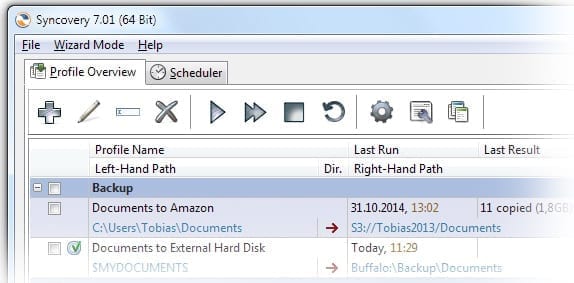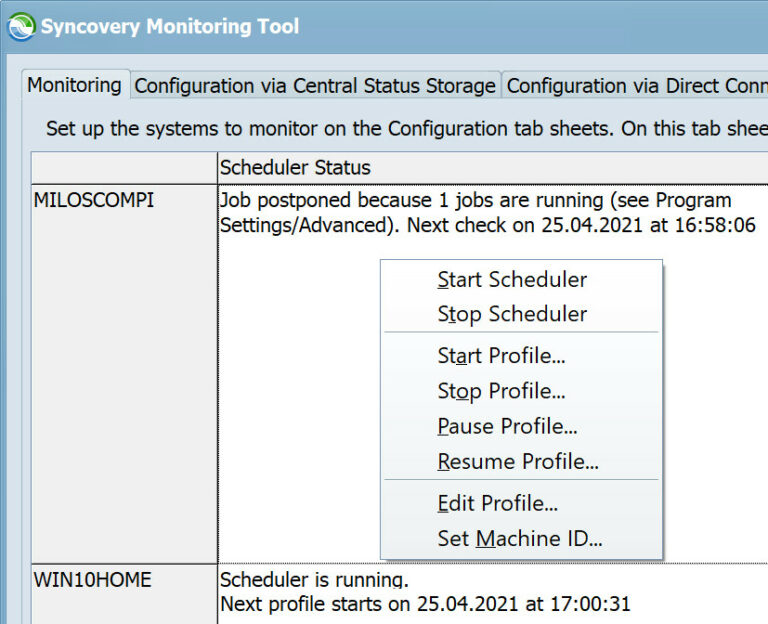
(2) Right-click all tick->Run Checked Profiles In Background to also achieve batch effects.ġ0. (1) Right-click all -> Run In Background to run batches, as shown in Figure 10

There are two ways to perform these two tasks Then two tasks appear, as shown in Figure 9.ĩ. The editing task only needs to modify the Right-Hand Side as shown in Figure 8. We definitely want to perform one-click copy of multiple machines at the same time, so here we can add the targets of other machines again, for example, we also want to copy the test data in the F drive of this machine on the 10.0.2.39 machine, so that we can create it again A backup task, a quick copy task: Right-click the 10.0.2.38 task and select Duplicate in the pop-up menu, and name the task 10.0.2.39, as shown in the figure. After completion, a backup task will appear in Synconver software, as shown in Figure 7: Interested students can study by themselves, and hope that they can give us advice.Ĩ. The advanced settings below the dialog box mainly set the filter conditions of the backup files in the folder, the backup time plan, etc. For comparison, we need to copy the contents of the test folder on the F drive to the test on the D drive of the 38 machineģ is the target file directory, that is, fill in the test file directory on the 38 machineĤ In order to choose the mode of copying files, we usually choose standard copy, that is, to achieve general copy and backup Pay attention to the position of the red frame:ġ is the name of this task, I usually use the remote login machine IP as the name, which is more clearĢ is the source file directory. Reopen the SynCovery software, click New Profile View Image, the ProfileSettings dialog box will pop up, and set the parameters, as shown in Figure 6: Open and find your test folder, and copy your address above: \\10.0.2.38\test as shown in Figure 5ħ.

Remotely access this disk from the local start menu -> run -> \\10.0.2.38, as shown in Figure 4 Set the shared attributes of the d:\test folder on the 38 nodes, and set the permissions to read and writeįigure 3 Log in remotely and set up sharingĦ. This is the most important one: first, we have to log in to our node, my IP is 10.0.2.38 and 10.0.2.39, and then open the two machines, Set the folder we want to copy to share, and specify the usage permissions, as shown in Figure 3. Next, the most important step is to prepare before remote replication. You can think of "+" to add a task, the pencil is to modify the task, View Image : run the task, etc.ĥ. You can see that there are many buttons on the toolbar. Then select AdvancedMode on the menu toolbar, as shown in Figure 2
#Syncovery login software
Open the software as shown in Figure 1:Ĥ.
#Syncovery login install
Download the corresponding version 32bit or 64bit, and install it directly by default, the next step is the next step ģ. I helped a lot, so I wrote this blog to record it here.Ģ.
#Syncovery login update
After a simple setting, you can implement batch processing on the windows system to backup and update the files of the remote server. Today I finally saw the artifact of Syncovery. Just imagine if there are as many commands as linux, it can be done by writing a batch process. Since there are many nodes and are on the windows system, we can only use the more complicated and continuous remote login to each node, and then use replication and replication on each machine.

The operation of updating the files on the remote server is currently in progress.


 0 kommentar(er)
0 kommentar(er)
